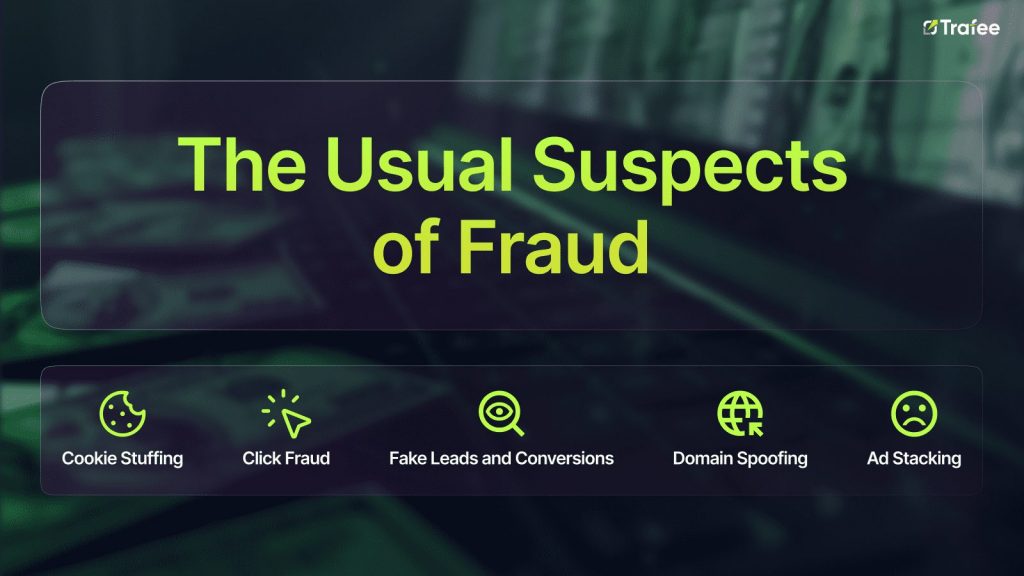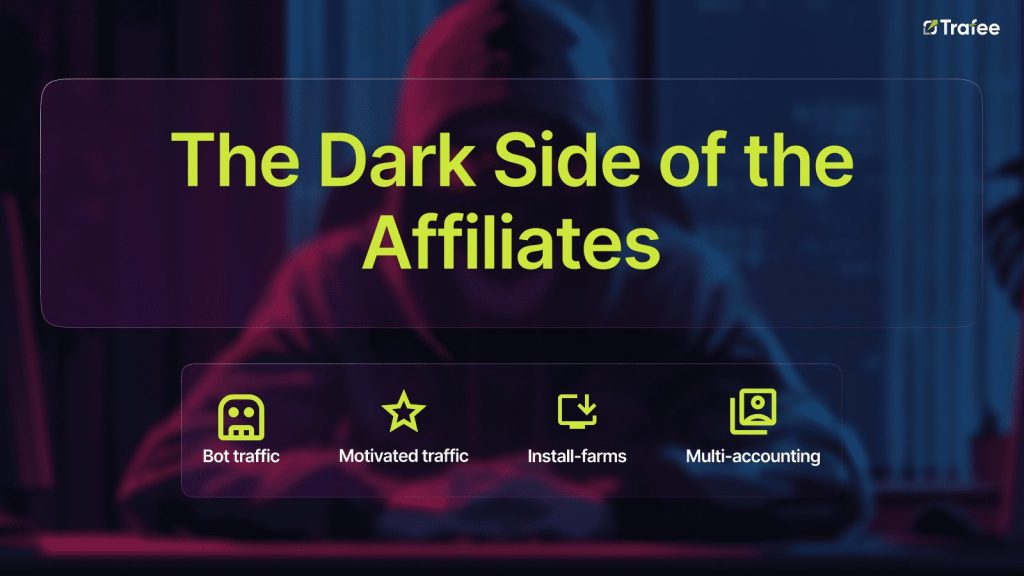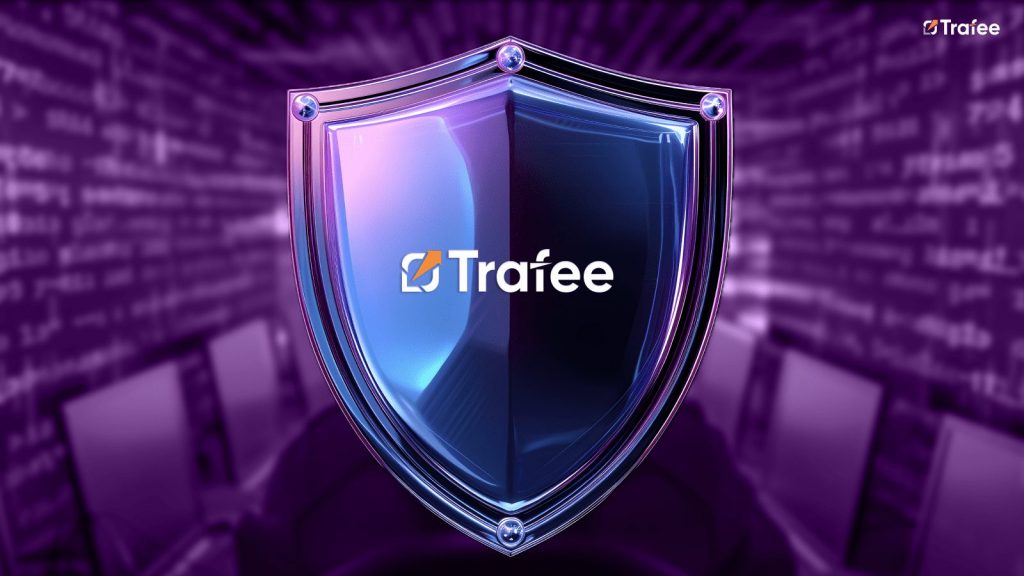Fraud, fraudsters, scammers… the nightmare of every affiliate, advertisers, partners, and everyone in between. At Trafee, we see them coming a mile away with our anti-fraud team’s secret weapon – Trafee’s Men In Black (Okay, maybe not actual spy agents, but they’re just as effective!)
This is your ultimate guide to understanding fraud in affiliate marketing, including how to spot it, the best tactics to fight fraud, and what Trafee does to keep things squeaky clean. Buckle up, affiliates, and let’s dive in!
Fraud 101: The Enemy of Profit
First things first, let’s break down what fraud means in our world. In affiliate marketing, fraud isn’t just about scams. It’s any black-hat or poor traffic that doesn’t bring advertisers or publishers any real money. Such a technique creates fake traffic or inflates data for personal gain.

A vivid example of fraudster traffic consists of bots, generated visits, automated scripts, masking, manual registration, and other methods that distort the actual volume and quality of traffic. Anything that messes with the real numbers and makes things look better (or worse) than they are. Recently, we caught someone trying to sneak past our defenses with VPN and Proxy traffic—busted!
Sometimes, fraudsters can be sneaky, hiding their tracks among real traffic, making it harder for affiliates and advertisers to see what’s happening. This can lead to a drop in campaign efficiency and, ultimately, frustrated partners who might ditch the whole thing.
So, who are these fraudsters, and what tricks do they have up their sleeves?
The Usual Suspects of Fraud
These digital tricksters come in all shapes and sizes – web admins, affiliates, marketers, and even some cybercriminals. Their goal is to score some easy cash (at your expense!) by using tactics like:

- Cookie Stuffing (also known as cookie dropping): This sneaky move involves replacing your affiliate cookies with another one, stealing your commission. You can think of it like a cookie monster swapping your delicious chocolate chip with a boring oatmeal raisin. Usually, they inject fake cookies into your browser and steal credit for never-mentioned conversions – this, unfortunately, goes unnoticed by average Internet users, which makes dishonest fraudsters earn on it.
- Click Fraud: Here, bots and scripts act like real users, clicking on your affiliate links like crazy and inflating your click-through rate (CTR). Even though it might seem like you’re getting tons of traffic, the reality is different. It’s a big fat illusion or a lie.
- Fake Leads and Conversions: These fraudsters are Bollywood actors pretending to be interested in a product or service just to claim the reward. You also might fill out our fake forms or install apps, but their real target is to drain your profits. It’s like going to a “free pizza” party only to discover that there’s no pizza and a bunch of empty promises.
- Domain Spoofing: Creating websites that look legit is another common trap crafted by fraudsters. They’re trying to steal your clicks and personal data, so don’t get fooled!
- Ad Stacking: For this one, let’s use our imagination. Just imagine a user clicking on an ad but getting bombarded with other ads. That’s exactly how their sneaky scheme works.
The Dark Side of the Affiliates
Sometimes, even affiliates can be tempted by the dark side. They might try to pass off the “low-quality” traffic as “high-quality,” sending fake clicks and conversions to advertisers. However, this not only hurts the advertiser but also ruins the reputation of honest affiliates like you.

In particular, these are the types of fraudulent traffic that are often encountered in affiliate marketing:
- Bot traffic – use of virtual robots that imitate the actions of real users. Bot traffic can be created both with the help of separate scripts and with the involvement of a botnet.
- Motivated traffic – users are offered to perform a targeted action in return for a reward.
- Install-farms – phishers can pay users to install applications or use automated systems.
- Multi-accounting – a fraudster creates many accounts with different IP addresses and browser profiles, from under which he or she follows his or her referral link and performs a targeted action.
Case Studies: Fraud in Action!
To understand these fraudsters better, mainly how they operate in the wild, let’s dive into real-world cases:
Dating Drama
A sneaky affiliate might create a fake profile of a super attractive person, luring users to click their link. But surprise, surprise — the “hottie” is nowhere to be found. What a pure disappointment! This leaves the user frustrated and the advertiser with wasted money.
Such a classic example of misleading users to generate fake clicks and conversion leaves affiliates with nothing but a broken heart and zero profit. Some affiliate networks, however, do not see such actions as fraud because part of the traffic remains on the site, and some people take part and register for advertisers' offers.
iGaming Shenanigans
In the world of gambling, pushing traffic from shady sources is a big no-no. It can be compared to showing up at a casino with counterfire chips. So, here, fraud could involve sending traffic from websites that violate advertising regulations. Remember, advertisers care about their brand image, and if they find out their traffic came from a questionable source – affiliates can kiss their commissions goodbye.
Another instance of fraud in iGaming is misleading or a promise that will never be true. Thus, the gamer pays a deposit and does not receive either money or a special bonus – the person leaves the game. At the same time, advertisers also do not earn anything and appear in the eyes of the user as “a theft,” as no bonus was received.
Trafee: Your Trusted Anti-Fraud Partner!
Let’s be honest—you might not see us as superheroes. After all, we flag fraudulent traffic, meaning you don’t get paid. So, why do you send us traffic and some of it gets blocked? That’s because we see everything, and by this, we mean every fraudulent or suspicious activity!
In particular, we act as super detectives. Our top-notch system sniffs out fraud attempts or any suspicious patterns you might not know about faster than you can say “shady click.” So, we monitor clicks, IP addresses, click-through rates (CTRs), user lifespans, and activity across locations and time zones. We also watch for the use of VPNs, proxies, and device emulators – all popular methods for fraudulent activity. We can't reveal every trick we use, but trust us, we're on the lookout!

And, now, to the main question – why work with us honestly? Here's the real benefit: filtering out "bad traffic" only sends high-quality leads to our advertisers. This premium traffic is in high demand, so advertisers are willing to pay more. And guess what? We share that higher revenue with our publishers – you!
Long story short, it's a win-win. Our unique anti-fraud system means better quality traffic for advertisers, which translates to higher payouts for our publishers. In simpler words, the more quality traffic you send us, the more we can pay you for it. It is always a good idea to monitor your traffic sources and watch for any suspicious activity like the ones mentioned above. So, block unfair practices, use specialized software, and take appropriate measures!
So, there you have it, affiliates! Now, you have the knowledge and resources to fight fraud and keep your campaigns squeaky clean. Remember, Trafee is always here to support you with transparent intentions!


